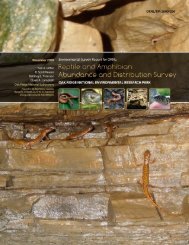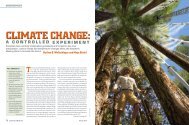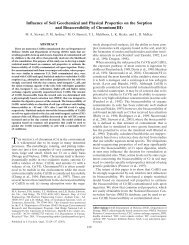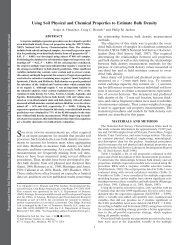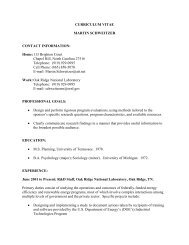Summary of Evaluation Findings, Recommendations, Next Steps ...
Summary of Evaluation Findings, Recommendations, Next Steps ...
Summary of Evaluation Findings, Recommendations, Next Steps ...
Create successful ePaper yourself
Turn your PDF publications into a flip-book with our unique Google optimized e-Paper software.
Table 2: USAID Regional Environmental Program for Southern Africa—<strong>Recommendations</strong> for Future Program Directions (2009-13)Recommendation(and related USAID Sub-Elementsunder Element 8.1 NaturalResources and Biodiversity)1. Technical Capacity Building 3(Biodiversity Policy andGovernance; Sustainable NRM andProduction; Science, Technology,Information)2. Increase Capacity forCommunication, Collaboration,and Cooperative Management 4(International Cooperation 5 )3. Data For Regional Water andBiodiversity Decision Support(International Cooperation;Science, Technology, Information)4. Regional Collaboration at aProvincial Scale for Local Planningand Development (BiodiversityPolicy and Governance;Sustainable NRM and Production;Science, Technology, Information)5. Regional Systems for Water andBiodiversity Research and Analysis(Science, Technology,Information—Regional)Examples <strong>of</strong> Proposed Activities to be Studied for PossibleInclusion in Future ProgramTraining topics include: hydrological data; water quality;watershed management; conserving biodiversity andecological services; integrated land use planning; GISapplications; water resource management; data analysis andmodeling; strategic planning; financial management and publicadministration.1.1 Standardization <strong>of</strong> procedures across region1.2 Improve data quality1.3 Build shared understanding and trust while strengtheningtransboundary perspective in problem-solving and research2.1 Improve technical capacity for assessing impacts <strong>of</strong> proposedactions (withdrawals, sediment diversions, intensifiedagriculture) on member states2.2 Preempt issues with proactive, science-based research3.1 Improve access to existing records, and capacities to monitorcurrent and future conditions3.2 Re-establish a practical, functional gauging network3.3 Develop a sustainable data collection and sharing systemsincluding GIS capacities3.4 Improve the understanding <strong>of</strong> species distributions andbiodiversity including extent and types <strong>of</strong> uses made by localcommunities3.5 Activities to ensure “ownership,” budgeting for continuation,and institutionalization <strong>of</strong> data collection, analysis and sharingprotocols3.6 Develop technical approaches to generate data andinformation in support <strong>of</strong> regional research and dialogue4.1 Work with partners to clarify appropriate channels forcommunications among stakeholders at all scales: fromcommunity resource users, to local authorities, to NCUs 6 ,RBOs and SADC (as appropriate, per issue).4.2 Assist OKACOM to develop effective means forcommunicating decisions and regional issues to appropriatedecision-makers in member states (regional and national levels)5.1 Improve capacity for data analysis and modeling to connectfacts with policy questions and issues.5.2 Develop regional data system management capacity5.3 Support joint technical studies responsive to basin planningand management needs5.3 Consider regional priorities (abstraction, sediments, waterquality)3
6. Enhanced StakeholderParticipation In Shared (Water)Resource Management(Biodiversity Policy andGovernance)7. Cross Basin Regional InstitutionalStrengthening: OKACOM,ORASECOM &/or others 7(International Cooperation)8. Sharing Best Practices andLessons Learned(International Cooperation:Biodiversity Policy andGovernance; Sustainable NRM andProduction; Science, Technology,Information)6.1 Build capacity and demonstrate participative policy anddecision-making for river basin management6.2 Develop frameworks and best practices for linking resourceusers with appropriate decision makers at various levels6.3 Share learnings though regional stakeholder exchanges7.1 Support structures and mechanisms for institutional renewal7.2 Enhance qualified human resource base for IWRM, impactassessment, and biodiversity conservation in a river basincontext7.3 Facilitate staff exchanges, case studies and best practices8.1 Organizing and Conducting Annual River Basin Organization(RBO) Meetings and follow-up actions;8.2 Develop RBO and SADC frameworks within which lessonsand experiences can be shared in the context <strong>of</strong> strengtheningrelationships8.3 Strengthening Relationships between OKACOM and otherbasin (ORASECOM, Kuando) as Prototype for Cross-BasinRegional Institutional Strengthening8.4 Publish joint papers on learnings from experiences withSecretariats, environmental assessments, stakeholderinvolvement, task forces, donor coordination etc.)Attachments:Table 3: Management Plan and Design Schedule, for the Regional Environment Program ElementAnnex 1: Guidelines for what is appropriate for “Regional” USAID program support1 See Annex 1, “What is Regional and Appropriate for Support under the USAID Southern Africa EnvironmentProgram Element”2 This includes: (a) wrap-up and transfer community work near Menongue ASAP while linking local counterparts toother sources <strong>of</strong> support for ongoing efforts; (b) staff appropriately to support SADC activities; (c) increase theintegration <strong>of</strong> priority regional components (RBO governance, capacity building and biodiversity conservation); (d)continue to explore ways to build regional capacity for collaborative research; and (e) pro-actively respond toOKACOM requests to support technical studies relevant to its charter, SADC Protocol, and USAID program goals,in close coordination with other donors.3 Support for training and capacity building must be carefully coordinated with other donors to develop a coherentset <strong>of</strong> complementary activities in the basin and to maximize benefits from regional economies <strong>of</strong> scale.4 Conflict mitigation and avoidance is an important by-product <strong>of</strong> the establishment <strong>of</strong> effective systems for transboundarycommunication and collaboration. As with prior recommendation, capacity building activities with RBOsshould be coordinated with SADC and other ICPs to maximize impacts and benefits from regional economies <strong>of</strong>scale.5 Due to the regional nature <strong>of</strong> this program, the “International Cooperation” sub-element is applicable to allactivities. It is only noted separately in cases where this is a primary desired outcome.6 National Coordinating Units (NCUs) for a shared river basin form one element <strong>of</strong> the GEF basin-wide planningproject; they will use existing institutional arrangements in each country to the degree feasible. Namibia has alreadyformalized NCUs for its major shared basins. Angola plans for decentralized basin planning and management units(with one proposed for Kuando Kubango Province—the Okavango and Kwando Rivers).7 Given relationships established with key regional stakeholders in Angola, Namibia and Botswana, other donors,the KAZA initiative, and SADC priorities, it may be useful to consider the upper Zambezi (Kuando-LinyantiCatchment) and/or other basin areas involving similar set <strong>of</strong> partners and issues.4
DRAFT Programmat <strong>Evaluation</strong> and Design Schedule for SO17-- Integrated River Basin Management= Mission decision point = CTO lead =RCO action =CTO w ORNL support = implementing partnerFY 2007FY 2008 FY 2009<strong>Evaluation</strong>Key Actions and Reports:IRBM Project Performance Assessmentsw/StakeholdersAnnual Workplans ApprovedDefine Eval SOW, team, preparations<strong>Evaluation</strong> ConductedDraft Evalutation Report Shared, RevisedMission approves final report, next steps, this planOctNovDecJanFebMarAprMayJunJulAugSepOctNovDecJanFebMarAprMayJunJulAugSepOctNovDecJanFebMarAprMayJunJulAugSepCommentsTo be organized by implementing partnerteampossibly with new partner(s)completecompletecompleteSee Action MemoApply Eval<strong>Recommendations</strong> andExtend IRBM ContractUSAID guidance to Imp. Partner: intent to extend 6months and apply evaluation recommendationsConsult OKACOM, SADC, stakeholders on recommd'actions and extension plans 2009-13Proposed activity summary docs-2009-2013 w/OKACOM and SADC "ok"MAARD/budget - Request 6 month extension underexisting IQC contractRCO Amends current IQC PACD to 31-3-09Letter from CTO, with RCO okInformal communications<strong>Summary</strong> descriptions and document "ok"from partnersNeed to define add'l outputs, results andbudgetMax. permitted under current IQCNew Activity Design (Phase II EnvironmentProgram)Concept/scope developed with stakeholder inputsDraft scope/budget MAARD for project designDesign effort tasked/contractedProposed follow-on design process, completedNew Activity Design reviewed, appv'd: USAID, SADC,OKACOMSolicitation docs and process reviewd with key partnersFinish scope/budget MAARD for implementing partner2009-11 (with option for 2 yr ext.)RCO issues solicitationTEC completes selection processNew implementing agreement negotiated, signedThis item is contemplated in PASA TORTo be completed in-house with PASA &EGAT supportTime frame to 2013 proposedProcess tbdTo be finalized in-house with PASA &EGAT supportOKACOM, SADC, KAZA? other RBOs?Scope, time-frame subj to USAIDguidance and funds availableTime needed for <strong>of</strong>fers to prep proposalsTEC could incl partner repsNew partner will need time to mobilizeCurrent IQC contract endsMaximum extension under current IQCXXCurrent ENV Program SADC Agreementrun thru FY09 funding/FY10implementation
What is Regional and Appropriate for Support under theUSAID’ Environment Program Element for Southern AfricaJuly, 2007USAID GuidanceUSAID defines regional programs as “those that serve regional goals and are not identifiedwith a specific bilateral program.” 1 Regional programs must meet at least one <strong>of</strong> thefollowing criteria:1. Providing support to regional organizations such as African Union, SADC,… (RBOs)2. Providing support to activities that serve a group <strong>of</strong> countries, such as regional trainingcentersRegional activities are those that advance the objectives <strong>of</strong> the new strategic framework forforeign assistance, but transcend a single country's borders, and are addressed outside acountry strategy. The activities should reflect strategic value-added and or economies <strong>of</strong>scale due to the use <strong>of</strong> a regional platform.The objectives <strong>of</strong> the Regional Environment Program are defined in the 2007 OperationalPlan. Additional guidance includes a 2006 Strategy Statement for the regional portfolio,including improved management <strong>of</strong> shared river basins, and the recently updatedPerformance Monitoring Plan. These documents are consistent with the general USAIDdefinition for regional programs above. Work performed under this program should bedesigned to generate measurable results with regional impacts.Environment Program for Southern Africa GuidanceU.S.G. support <strong>of</strong> improved river basin and water management and biodiversity conservationfrom the regional platform in Southern Africa, should demonstrate clear linkages to:a) Regional priorities for basin and water resource management (defined by SADC andor corresponding RBO) and/or conservation <strong>of</strong> regionally (or globally) threatenedspecies and ecosystems (defined by IUCN and regional collaborators). Note thatfreshwater ecosystems are recognized as the most threatened biome on the planet,and certainly the most threatened in Africa.b) Leadership by or through regional counterpart organizations (SADC, RBOs, IUCN orothers)c) Actions that address prioritized threats to ecosystem services and biodiversity thatcould impact the overall basind) Geographic locations prioritized regionally as biologically important arease) Approaches that reinforce a “shared resource, shared benefits” concepts by involvingall riparian states in the processf) Processes that strengthen effective linkages between and among regionalorganizations (SADC, OKACOM), national organizations, provincial and localauthorities – showing how this can add valueg) Demonstrating the capacity for regional platforms to build consensus, mitigateconflict, and more effectively address issues <strong>of</strong> mutual interest than any single nationcould if working aloneh) Actions that take place in an upstream nation, but are actively supported by downstreamnations due to expected sharing <strong>of</strong> benefitsi) Processes that build regional constituencies for IWRM, IRBM, biodiversityconservation and effective RBO services
j) Actions that are “owned” and supported by multiple riparian states and involve keystakeholders from multiple nations in the process <strong>of</strong> design, implementation, andassessing activity progress and impacts.k) Demonstrated respect for the ‘subsidiarity principle:’ the regional program should notsupport work that can be better and more appropriately done bilaterallyl) Activities such as regional training that show significant economies <strong>of</strong> scalem) Support for multi-national groups and organizations established to address transboundarynatural resource management and biodiversity issues.USAID/Southern Africa defines “support to regional organizations” to include support toregional organizations through multi-country networks that span the region and have somerecognition by the regional organization. SADC requires such networks to support effectiveimplementation <strong>of</strong> regional agreements and protocols. Implementation may <strong>of</strong>ten beundertaken by public and private partnerships that work within the SADC framework.Concerning economies <strong>of</strong> scale, in addition to training, there are appropriate roles forregional platforms to provide technical assistance on harmonizing regional standards,policies, procedures, regulations, laws, etc. This needs to done in close coordination withbilateral missions, other donors and under an appropriate regional institutional framework.Finally, a regional platform can add unique value by collaborating with bilateral missions indeveloping constituencies along watersheds and wildlife corridors. Constituency buildingacross a group <strong>of</strong> countries that share the same watershed and wildlife resources, can leadto increased ownership and shared responsibility, respect for other “users” across borders,build confidence among various stakeholders, support more efficient use <strong>of</strong> soil and water,and demonstrate measurable improvements with trans-boundary impacts through planningand cooperation among groups sharing the watershed. A necessary part <strong>of</strong> multinationalwatershed planning is consultation and buy-in by the people living there and using theresources.1 From U.S. Foreign Assistance Reform web site: http://inside.usaid.gov/A/F/programs.html“Guidance - Global, Regional, and Central Programs”




